 Agonizing, intolerable, miserable, excruciating, stabbed with a knife, worse than childbirth.
Agonizing, intolerable, miserable, excruciating, stabbed with a knife, worse than childbirth.
As a urologist specializing in the treatment of patients with kidney stones I have learned a new lexicon exclusive to stone formers describing bouts of renal colic.
Pain, the hallmark symptom of stone disease, accounts for over one million emergency room visits by such patients in the United States each year.
Over the past several decades considerable progress has been made gaining insight into the physiology of renal colic and optimizing methods to treat it. However, despite improved scientific explanations we as clinicians still lack a perfect understanding of why it occurs.
PAIN FROM STONE PASSAGE
Patients have been suffering from renal colic secondary to stone disease for over two thousand years. As a matter of fact, it is remarkable how little has changed in its clinical presentation over this time period. In 400 B.C. Hippocrates referred to it as first disease of the kidneys. He was one of the initial observers to comprehend the association between urinary obstruction and pain, writing:
An acute pain is felt in the kidney, the loins, the flank and the testis of the affected side; the patient passes urine frequently; gradually the urine is suppressed. With the urine, sand is passed; as the sand passes along the urethra, it causes severe pain which is relieved when it is expelled; then the same sufferings begin again.
We have since come to appreciate the complex physiologic basis for this relationship at a much deeper level.
How Pain Begins
 The first step in this process is acute obstruction, most commonly from a stone. But in stone formers masses of crystals can create obstruction, as can blood clots if bleeding is particularly brisk.
The first step in this process is acute obstruction, most commonly from a stone. But in stone formers masses of crystals can create obstruction, as can blood clots if bleeding is particularly brisk.
Urine from the kidney can no longer pass to the bladder and as a result builds up and stretches the proximal – closest to the kidney – ureter and renal collecting system. This stretch activates nociceptive nerve fibers – fibers which sense injury – within an entire neuronal network located submucosally in the renal pelvis, calyces, capsule and ureter.
Figure 1 (left) – Example of obstructing proximal ureteral stone with dilation and stretch of the collecting system above the level of obstruction.
These fibers then transmit afferent signals to the T11 – L1 spinal cord which the body interprets as pain at the corresponding level of neuronal activation. As the stone migrates from the kidney down the ureter and towards the bladder, pain usually shifts downward as well. It is commonly sensed as high as the upper flank when the stone is lodged in the proximal ureter and as low as the labia/testicle when down near the uretero-vesical junction at the entry to the bladder.
Patients passing stones may experience other symptoms in addition to pain. Many of the nerves involved in the process of obstruction are intimately linked to innervation of adjacent organs, for example the gastrointestinal tract. Cross activation of these associated nerve fibers has been proposed as an explanation for the nausea and vomiting which so often occurs in the setting of an acute episode of renal colic.
In rare instances patients may even have alternative symptoms without any pain at all. In some cases, particularly when the stone is at the uretero-vesical junction, urinary symptoms predominate and the only appreciable symptoms are urinary frequency, urgency and discomfort while voiding. These symptoms mimic urinary infection and often result in temporary mis-treatment with antibiotics until the correct diagnosis is made.
What Happens Later
Increasing renal pelvis pressure from persistent obstruction causes a release of prostaglandin E2. This chemical mediator of injury response produces a perfect storm.
It causes ureteral hyperperistalsis (increased intensity of the waves of coordinated ureteral contractions which normally drive urine down to the bladder) and eventually even ureteral spasm. It also leads to dilation of the afferent arterioles – those tiny resistance vessels which control the flow of blood into the capillaries of the kidneys.
The arteriolar dilation increases blood flow to the kidney and promotes a temporary diuresis just as ureteral smooth muscle hyperperistalsis and ultimately spasm tighten the ureter around the stone and worsen obstruction. Spasm leads to lactic acid build up, as occurs when any muscle is over-exercised, and sets off an inflammatory cascade that itself can worsen pain.
With time, blood flow to the affected kidney falls, even though the arterioles which let blood into the renal capillaries remain dilated. It falls because the efferent arterioles, which let blood out of the capillaries where filtration occurs, begin to constrict and raise filtration by the renal glomerulae. The increased filtration maintains and can even raise pressures.
Figure 2 – Diagram of blood flow to the nephron. Blood enters through the afferent arteriole and is then filtered within the glomerulus, producing urine in the process. Blood exits through the efferent arteriole. Both the afferent and efferent arteriole are able to dilate and constrict in order to regulate pressure and ultimately filtration via urine production.
In many ways, this complex system is analogous to the soaker hoses many people use to water their lawns. The afferent arterioles are the faucet the hose is connected to and the efferent arterioles are the opening at the end of the hose which can be closed or left open into a sprinkler.
Filtration is the many tiny flows of water all along the hose which keep the grass growing.
When working appropriately, the faucet and the end are both open and water (urine) is produced at a slow, constant rate (Figure 4 – left). With an obstructing stone the faucet – so to speak – is opened more and the end clamped more so more fluid – water – is filtered out along the length of the hose at high pressure (Figure 4 – right). In the kidney this filtration is into the nephrons and raises pressure. When the clamp is tightened, the total amount of flow through the hose can fall just as the amount of water filtered out along the hose rises.
Figure 4 – Soaker Hose Analogy to Renal Blood Flow and Filtration. On the left, there is little pressure in the system and water (urine) seeps out slowly from along its length. On the right, the inflow is much higher than the outflow and water (urine) shoots out from along the hose at exceedingly high pressure.
Three Phases of Pain in more Detail
The Physiology
No discussion regarding ureteral obstruction would be complete without the work of E. Darracott Vaughan, who characterized the physiology of urinary obstruction in the 1970’s.
Assuming two functional kidneys, the physiologic effects of acute unilat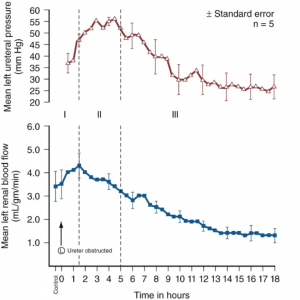 eral ureteral obstruction can be marked by three distinct phases.
eral ureteral obstruction can be marked by three distinct phases.
In phase one, the effects of the inflammatory cascade described above cause a progressive rise in renal blood flow and renal pelvis and ureteral pressure. This phase lasts for approximately one to one and a half hours. This is the portion where the afferent arteriole – the faucet – is maximally opened.
Phase two is marked by efferent arteriolar vasoconstriction which causes a decrease in overall renal blood flow but an increase in ureteral pressure for up to five hours. The faucet is opened and the end clamp is tightened.
Phase three is marked by a further decrease in renal blood flow to the affected kidney and ultimately decreased ureteral pressure. The end clamp is progressively tightened so blood flow to the kidney is reduced enough that filtration and urine production begin to fall, and pressure with it.
Measurements of ureteral pressure (red) and renal blood flow (blue) after onset of acute unilateral ureteral obstruction. (Courtesy Campbell-Walsh Urology, Tenth Edition, Elsevier Inc.)
The fall in blood flow is not injurious during an acute attack, but over time it can be. This means that relief of an obstructing stone is an important matter. Commonly stones pass of themselves. But stone attacks need medical attention because if the stone continues to obstruct it must be removed.
The Symptoms
It is easy to conjecture how these three distinct phases correlate clinically to the symptoms experienced during an acute episode of colic.
The onset of pain classically correlates to phase one and the inciting obstructive event. It is at this point that the patient commonly seeks care in the emergency room or physician’s office.
The pain classically persists at a severe level for several hours (phase two) but ultimately subsides, at least partially (phase three).
In many instances pain comes in waves, potentially a sign of intermittent obstruction activating the above pathway each time urinary flow is obstructed. This occurs through a combination of the stone moving and the tensions of the ureter with increases or decreases of muscle spasm.
THE CONUNDRUM – Pain Without Obstruction
Opinions of Urologists in General
Though the physiologic basis of pain in the setting of obstruction is clear, it does not provide an explanation for one of the most commonly encountered conundrums in stone disease – the symptomatic non-obstructing stone. These can be actual free stones that have not passed, stones attached to plaque, or actual plugs in the kidney tubules that are massed together enough to show up on a CT scan as ‘stones’ though actually tissue calcifications.
There is perhaps as much variation in clinical opinion in such instances as any other clinical scenario in the field.
If one were to ask a group of urologists whether they believed that small nonobstructing stones could cause renal colic, opinions would range from absolute certainty to complete dismissal of the concept altogether.
What Happens to Patients
As a result, there is no standard of care regarding how to optimally manage such patients. In all cases it is first imperative to rule out other potential sources of pain; however, such workups often end with the same result – a patient with bothersome flank pain and evidence of one or more nonobstructing stones on imaging.
Lacking a physiologic explanation to explain their symptoms, patients with pain and non obstructing stones are often sent for detailed workups, secondary and tertiary consultations and referral to pain specialists and even psychiatrists. However, in an age where flexible ureteroscopy can be performed quite safely and on an outpatient basis one must wonder whether such patients are being treated appropriately.
A Specific Example
As an example, I recently met a patient who had been referred from several hours away seeking a fourth opinion regarding her chronic flank pain. For months she had suffered from a severe ache in her left flank that had limited her ability to work and live her normal life.
She had attributed the pain to a 7 mm lower pole nonobstructing renal stone on that side which was discovered on a CT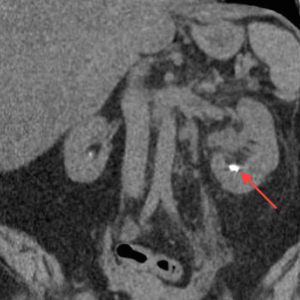 scan during her initial presentation to an outside emergency room (Figure 3). However, none of the physicians she had seen agreed with her self diagnosis.
scan during her initial presentation to an outside emergency room (Figure 3). However, none of the physicians she had seen agreed with her self diagnosis.
Figure 3 – CT image of left lower pole nonobstructing stone (red arrow). There is no evidence of obstruction or inflammation around the kidney.
In the ER she was given narcotic pain medication and sent home to follow-up with a urologist.
The first urologist she saw told her that while the stone was visible, its location within the kidney meant that it could not possibly be causing her pain. He refilled her prescription for pain medication and sent her to see a pain specialist.
The pain specialist tried physical therapy for what he thought may be a musculoskeletal source but ultimately this did not prove effective and she was given more pain medication.
She later sought care from a second urologist who also told her that the stone could not possibly be causing her pain in the absence of obstruction. This time however she was accused of having an agenda and seeking care specifically to get pain medication. Similar visits to a variety of emergency rooms elicited more CT scans as well as accusations of seeking pain medications. Each CT result was the same though, all demonstrating a 7 mm non obstructing left lower pole stone.
On one instance a treating practitioner even admonished her, saying that nonobstructing stones don’t cause pain and he should know since he too had been diagnosed with such stones incidentally on a CT scan.
Ultimately she made her way to the clinic for consultation at which point she was offered a ureteroscopy and stone removal. The procedure went well and she was discharged with a stent for one week. She was last seen back 5 weeks after the procedure and reported complete resolution of her pain. She was no longer taking any pain medication whatsoever and there was no evidence of any stone or hydronephrosis on follow-up imaging.
What is Known to Date
Such patients are frequently encountered. Despite a lack of physiologic explanation as to why these non-obstructing stones may cause pain, there is emerging evidence that they do and therefore that removal can cure it.
In 2006 Taub et al. described outcomes of twenty such patients who had chronic flank pain as well as radiographically evident calcifications within their papillae without obvious collecting system stones. Ureteroscopy with laser papillotomy to unroof and remove all evident stone was performed on twenty seven kidneys. Pain improvement was seen in 85% of cases with a durable improvement for greater than one year in nearly 60% of cases.
This study was then repeated on a multi-institutional level with 65 patients undergoing similar procedures over a ten year period. Overall there were 176 procedures performed in this cohort with patients reporting less pain after the procedure 85% of the time. The mean duration of response was 26 months with 60% of patients having sustainable improvements in their pain levels for over one year.
Finally, this clinical scenario is seen commonly enough that it garnered its own nickname at Massachusetts General Hospital where it has been described as “small stone syndrome”. In a retrospective review of patients treated there with ureteroscopic removal of small nonobstructing stones (<4mm) for reasons related to chronic pain, 11/13 patients reported being pain free after the procedure with the other two noting a partial response.
What I think
We still do not completely understand the physiologic explanation for pain in these patients. However, much like Hippocrates over two thousand years ago, clinical observation often precedes scientific understanding. In this regard it is unfair to dismiss the notion that small non obstructing stones can elicit legitimate renal colic.
Physiologic breakthroughs in the understanding of pain signaling and inflammation are currently happening at a rapid rate and it is likely that in time we may be able to better decipher which non-obstructing stones are truly responsible for symptoms. However, until then, such scenarios will continue to be a commonly encountered clinical complexity for urologists.
For the time being I would still advocate consideration of alternative causes of pain in such situations including urinary infection, obstruction and malignancy. A careful history is critical to rule out non-urologic sources such as pathology within the musculoskeletal, pulmonary, gynecologic and gastrointestinal systems. Another important element of the history is whether the patient has previously passed a stone and if the current symptoms are similar to that experience.
Once other explanations have been ruled out, offering stone removal is entirely reasonable. This not only has the potential to improve pain but may also decrease the risk of future stone growth or spontaneous passage at a later date. In such instances, I prefer flexible ureteroscopy with stone removal to shock wave lithotripsy. First, ureteroscopy maximizes the likelihood that all stones can be identified and removed which is especially important in the event that pain persists after the procedure. Second, with ureteroscopy one can inspect the inside of the kidney in high definition which has the potential to offer information not readily available on x-rays and CT scans such as embedded stones, tissue calcifications, and other pathology (Figure 4).
Figure 4 – High definition images obtained during renal endoscopy demonstrating tubular plugging (stones embedded in the kidney) (Courtesy: AE Evan, IMCD and BD plugs: Do they have a role in stone formation).
Finally, it is critical to establish realistic expectations before surgery in regards to pain control. Our understanding of this concept is in evolution and the published literature suggesting a treatment response is limited to relatively few patients. However, as science and history have shown us, just because we don’t fully understand the connection doesn’t mean it doesn’t exist.
More You Might Like
What Kidney Stones Are
Types of Kidney Stones
Do We Need to Analyse All Those Stones?
How Kidney Stones Form
When Crystals Plug The Kidneys
Medullary Sponge Kidneys


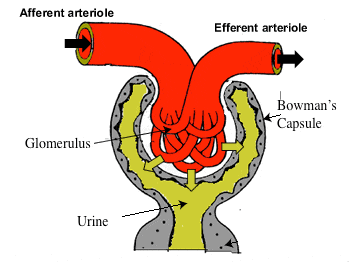
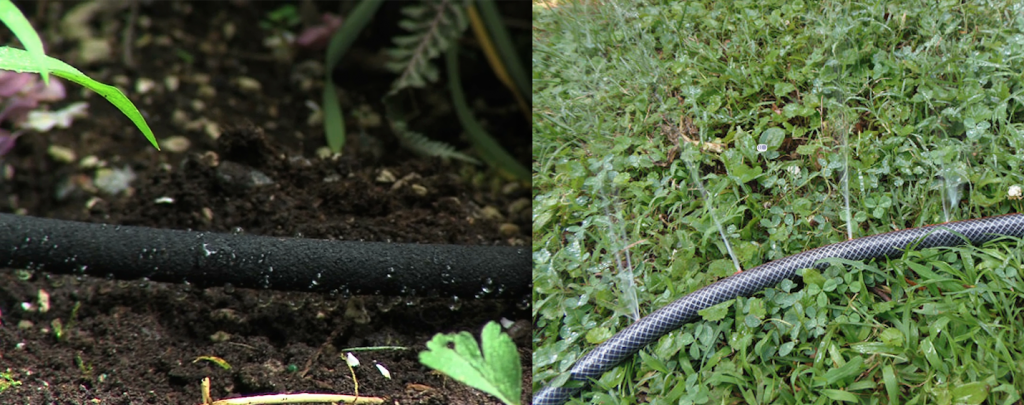
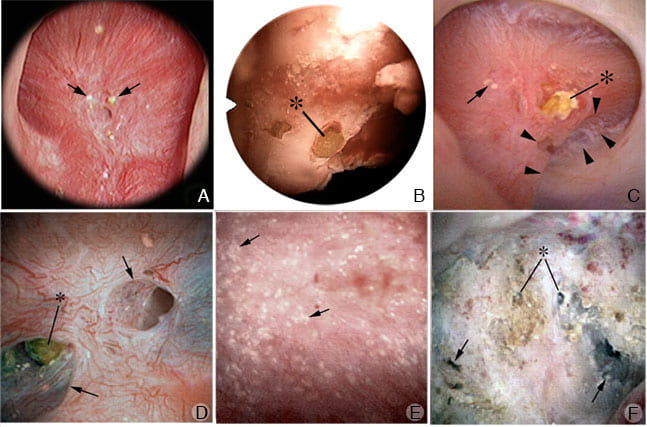
I continue to pass at least 25+ small kidney stones/gravel a year. I keep them as proof. Imaging is usually normal or may show a “punctuate” stone with the radiologist quick to write that it’s not causing pain/hydronephrosis.
Every 6-15 months I double over with pain that seems to be coming from a blocked ureter. Imaging isn’t impressive. The colicky pain responds to Ditropan but doesn’t help move the unseen gravel on its way.
I have history of a stenotic infundibulum that had an 8mm fragmented stone burden behind the narrowing. The IVP had been ignored for 7 years until a newly graduated urology attending read the IVP Imaging as a stenosis. The experienced urologists just wanted to keep doing lithotripsy. Fortunately, I went down to Indianapolis and had a PERC completed. The stenosis was balloon dilated but unfortunately the calyx was already damaged from 7+ years of misdiagnosis and hydrocalyx.
What I don’t understand is the regular repeats of what no one wants to call spontaneous Stein Strausse. Is the damaged calyx creating stone gravel that gets clogged in the ureter? Are the formed stones harboring infection that periodically pops out with a fragment? My 2022 urology history… had 3 REALLY bad urine infections up in the kidney ….UA was completely normal. Stone fragment pops into urine and the infection runs its course. I’ve also had 2 different ESBL infections with E Coli and Klebsiella. The klebsiella ended up being resistant to ALL oral antibiotics. Needed PICC line for 28 days to get rid of that infection!!!
I am currently in the middle of another episode of horrible flank/ureter/bladder pain. I am made to wait a month or more to see if it goes away by itself. 3 month wait during covid…was very angry being left in that increasing pain. I just got the call from the surgery scheduler late Fri afternoon for surgery 7-19-23!!
How is stein strausse or other stone blockage treated if not seen on imaging….NOTHING. Unless you find a urologist who is willing to do a ureteroscopy to take a look. Nothing is usually found. The gravel is flushed all over the place just by the nature of the ureteroscopy. There’s got to be a better way to diagnose this. I’ve had at least 10+ ureteroscopies so far and I am scheduled for another one on Weds. 4 weeks of colicky pain with bloody urine is enough. 5 stone fragments passed so far from 6-15-23 to 7-7-23.
But how do we STOP this from happening?? I can’t keep submitting myself to anesthesia etc. I can’t keep doubling over from blockages unseen on imaging….and then I’m accused I’m faking all of this for attention. Ugh. I have better things to do with my time!!!!!
How do we test the one damaged calyx to see if it’s popping stones and harboring infection? Could there be a fistula there from the PERC? Could the partially duplicated renal pelvis be part of the problem….stagnant urine in an incompletely developed ureter.
I’m terrified for Weds 7-19-23. Another trip to the OR to flush me out but I’m afraid no answers to how to stop the stone fragments and the infections. (Last UTI infection Apr 2023. Fever to 103.4 for a “simple E Coli infection”. Otherwise 6+ other UTIs in 2022…hospitalized for half of them)
Dr Coe…I simply have no clue what to do anymore. I fear another one of these “simple UTIs” will be my demise with a fever to 103.4. No one knows what to do with me or is willing to help me figure it out.
I’m terrified!!
ANY ideas will be greatly appreciated. Thanks much.
Hi Doris, You have a superb surgeon in Indy, Dr James Lingeman, and I presume you are seeing him. I believe I have seen you in the past, as well. I trust Dr Lingeman to take care of your urology. Please let me know if there is a problem in seeing him. I do not know the other urologists at IUPUI. Regards, Fred Coe
Hello Dr Coe,
This Q&A message board is a long read. Do you have a referral in the Phoenix area?
I’m 99% sure I’ve been experiencing pain from a 12mm non-obstructed stone. Left kidney, lower. I’ve had 4 back surgeries in the last 2 years and I’ve been assuming my kidney pain was back related. Anyway, my last fusion surgery on 6/20/23 was a success and the only pain I have left is the left kidney. I’m certain about this because I know my body. And, I just had lithotripsy that went real bad post-op. i.e. pain, ER visit
Anyway, my Urologist is is the doctor that takes a dogmatic stance that my pain is not from the stone. I’ve had 2 other lithotripsies a few years back and none of them were close to this one on the pain. Anyway, he may offer the ureteroscopy procedure but I won’t know until next week. I’ve been through too much with my back surgeries to leave this stone in my kidney. I need to be 100% sure it’s not ongoing issues with my back. Thanks for listening and please wu me know if you have referral(s) in the Phoenix/Mesa AZ area, thanks!
Hi WIlliam, Mayo Clinic has a branch in Phoenix and I would try to use their stone experts. Regards, Fred Coe